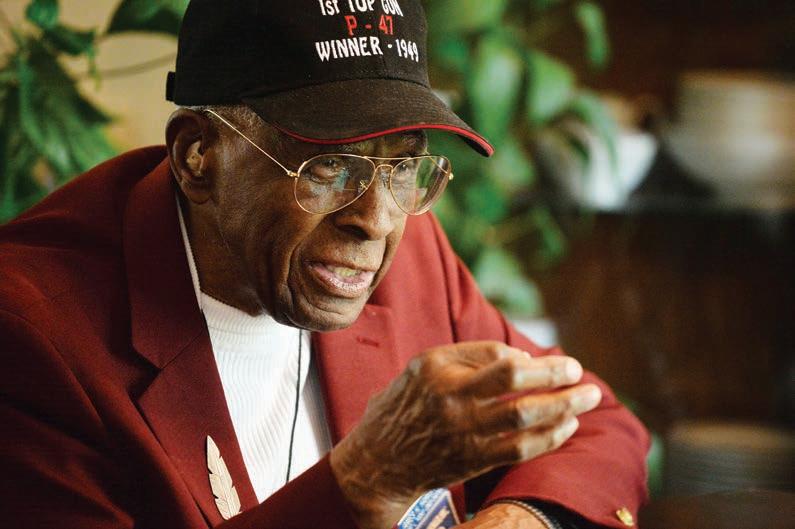
3 minute read
TOP GUN
he applied to the Aviation Cadet Training Program in hopes of being accepted into the Tuskegee Flight Training Program in Alabama, a separate school designated for Black pilots.
In 1925 the U.S. Army War College released a report called “ e Use of Negro Manpower in War.” Many say this report “set the overall tone” for how the military viewed Black men.
e report stated they “lacked intelligence and were cowardly under combat conditions” and lacked the “ability to operate complex machinery.”
To prove this, the U.S. Army set up an “experiment” in 1941 to prove the ndings of the War College report.
Tuskegee was an experiment that was designed to fail — to prove that Black men didn’t have the capacity to y.
But instead, the program produced some of the nation’s most pro cient ghter pilots.
“I applied. I was accepted,” said Harvey. “However, I had to take an examination rst, and there were 10 of us that reported to Bolling Field to take this test — nine Whites and myself.”
Both Black and White candidates took the same preliminary tests to get into the Aviation Cadet Program. Black pilots, however, would be trained at a segregated eld in Alabama.
Testing for this program was known among servicemembers to be notoriously rigorous and particularly unforgiving.
“Well, we took the examination, did everything they wanted us to do, and when the dust cleared, there were only two of us standing — this White guy and myself,” Harvey said.
Long were the hours and challenging were the tasks for Harvey, a self-described perfectionist.
“If everything is perfect, there’s no challenge after that,” he said. “I never dreamed or thought about washing out in ying school. I knew I was gonna make it because I did everything right.”
Because, as a Black man, he had to.
“You only had so many hours or days to learn something and if you didn’t, you were out. It’s that simple,” Harvey said. “You only had a certain amount of time to learn something and if you exceeded that time, you were gone.”
When asked if he’s still a perfectionist, he grins.
“Well, I’m back at it,” he laughs. “I got married, so that was kind of the end of the perfectionism, but my wife passed, so I’m back at it again.” Perfectionism.
“I’ve always been that way,” Harvey said. “Like Disney, when I was growing up … the Disney characters, I’d sit down and draw them — they were better than what Disney put out!”
His favorite?
“Mickey Mouse, of course … I don’t think Minnie was on the scene yet.”
So, what should we call you?
Harvey earned his wings at Tuskegee Army Air Field on Oct. 16, 1944, near the end of the war. A graduate of Class 44-4, he was commissioned as a second lieutenant and began his career as a ghter pilot.
While many Tuskegee Airmen were already ying in Europe, protecting heavy bomber aircraft on their way to strategic targets, Harvey did not get that opportunity.
“ at’s because Hitler knew I was coming and he gave up the following month,” he joked. “I was supposed to ship in April 1945. And I had my bags packed, ready to catch the train, and I got a message the war was over and they expected the wind-up of the whole European theater.”
On July 26, 1948, President Harry S. Truman signed Executive Order
9981, creating the President’s Committee on Equality of Treatment and Opportunity in the Armed Services and banning segregation in the Armed Forces.



Harvey says the order was a step in the right direction, but it also meant his unit would be disbanded and its personnel integrated into other units that would “have” them.
Harvey explains how that became complicated for Black pilots.
Prior to his departure, he, and another Tuskegee Airman, Eddie Drummond, were to be transferred from Lockbourne Air Force Base in Ohio to a base in Japan. However, before they arrived, their personnel les — which included their o cial photos — were forwarded to the gaining military unit.
“So, you see, the wing commander had our picture,” Harvey said. “So, Eddie and I report to Misawa, Japan, and before we got there, he had all the pilots report to the base theater and he told them, ‘We have these two Negro pilots coming in and they will be assigned to one of the squadrons.’ e pilots said, ‘No way are we going to y with them. No way.’”
Harvey said he and Drummond were told about the meeting by the pilots themselves.
Regardless of the sentiment, Harvey and Drummond were there to stay and were assigned to a unit ying the Lockheed F-80 Shooting Star.
As they wrapped up their initial meeting, Harvey said the man who would be their new wing commander casually asked, “So, what do you want us to call you?”
An uncomfortable moment of silence ensued.
“I said, ‘Well, I’m a rst lieutenant and Eddie Drummond is a second lieutenant … how about lieutenants Harvey and Drummond?’”
First ‘Top Gun’
In January 1949, the newly-recognized Air Force, thanks to the National Security Act of 1947, issued a directive to all ghter squadrons about an intramural weapons competition.










